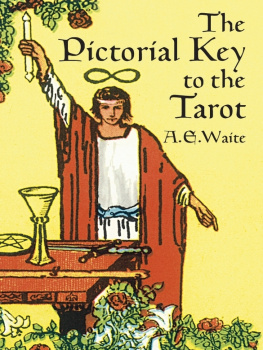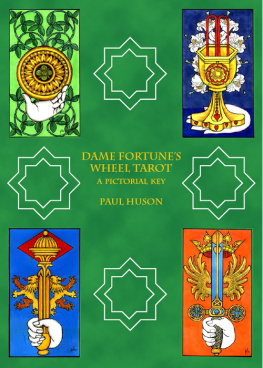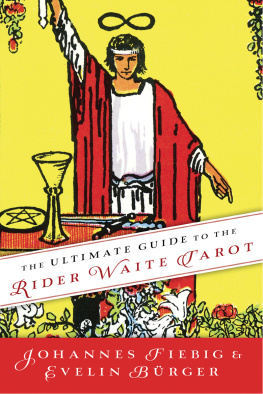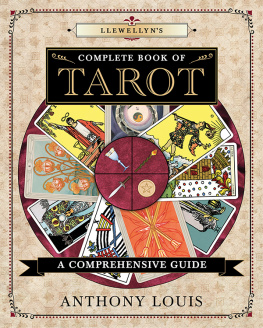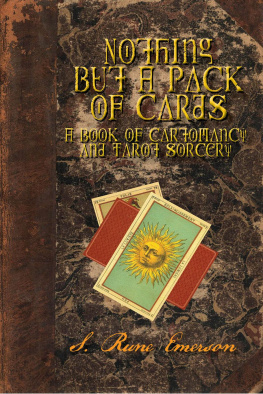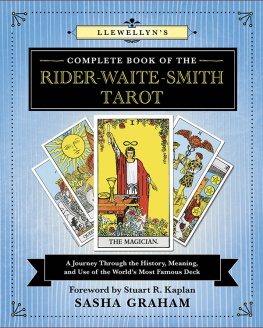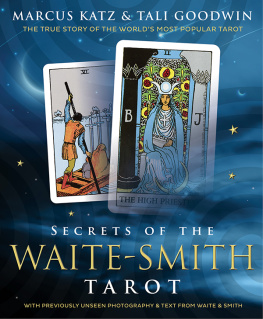A. E. Waite - The Pictorial Key to the Tarot
Here you can read online A. E. Waite - The Pictorial Key to the Tarot full text of the book (entire story) in english for free. Download pdf and epub, get meaning, cover and reviews about this ebook. year: 2012, publisher: Dover Publications, genre: Religion. Description of the work, (preface) as well as reviews are available. Best literature library LitArk.com created for fans of good reading and offers a wide selection of genres:
Romance novel
Science fiction
Adventure
Detective
Science
History
Home and family
Prose
Art
Politics
Computer
Non-fiction
Religion
Business
Children
Humor
Choose a favorite category and find really read worthwhile books. Enjoy immersion in the world of imagination, feel the emotions of the characters or learn something new for yourself, make an fascinating discovery.
The Pictorial Key to the Tarot: summary, description and annotation
We offer to read an annotation, description, summary or preface (depends on what the author of the book "The Pictorial Key to the Tarot" wrote himself). If you haven't found the necessary information about the book — write in the comments, we will try to find it.
The Pictorial Key to the Tarot — read online for free the complete book (whole text) full work
Below is the text of the book, divided by pages. System saving the place of the last page read, allows you to conveniently read the book "The Pictorial Key to the Tarot" online for free, without having to search again every time where you left off. Put a bookmark, and you can go to the page where you finished reading at any time.
Font size:
Interval:
Bookmark:

A CONCISE BIBLIOGRAPHY OF THE CHIEF WORKS DEALING WITH THE TAROT AND ITS CONNEXIONS
As in spite of its modest pretensions, this monograph is, so far as I am aware, the first attempt to provide in English a complete synoptic account of the Tarot, with its archological position defined, its available symbolism developed, andas a matter of curiosity in occultismwith its divinatory meanings and modes of operation sufficiently exhibited, it is my wish, from the literate standpoint, to enumerate those text-books of the subject, and the most important incidental references thereto, which have come under my notice. The bibliographical particulars that follow lay no claim to completeness, as I have cited nothing that I have not seen with my own eyes; but I can understand that most of my readers will be surprised at the extent of the literatureif I may so term it conventionallywhich has grown up in the course of the last 120 years. Those who desire to pursue their inquiries further will find ample materials herein, though it is not a course which I am seeking to commend especially, as I deem that enough has been said upon the Tarot in this place to stand for all that has preceded it. The bibliography itself is representative after a similar manner. I should add that there is a considerable catalogue of cards and works on card-playing in the British Museum, but I have not had occasion to consult it to any extent for the purposes of the present list.
Monde Primitif, analys et compar avec le Monde Moderne. Par M. Court de Gebelin. Vol. 8, 4to, Paris, 1781.
The articles on the Jeu des Tarots will be found at pp. 365 to 410. The plates at the end shew the Trumps Major and the Aces of each suit. These are valuable as indications of the cards at the close of the eighteenth century. They were presumably then in circulation in the South of France, as it is said that at the period in question they were practically unknown at Paris. I have dealt with the claims of the papers in the body of the present work. Their speculations were tolerable enough for their mazy period; but that they are suffered still, and accepted indeed without question, by French occult writers is the most convincing testimony that one can need to the qualifications of the latter for dealing with any question of historical research.
The Works of Etteilla. Les Septs Nuances de Iuvre philosophique Hermtique; Manire de se rcrer avec le Jeu de Cartes, nommes Tarots; Fragments sur les Hautes Sciences; Philosophie des Hautes Sciences; Jeu des Tarots, ou le Livre de Thoth; Leons Thoriques et Pratiques du Livre de Thoth all published between 1783 and 1787.
These are exceedingly rare and were frankly among the works of colportage of their particular period. They contain the most curious fragments on matters within and without the main issue, lucubrations on genii, magic, astrology, talismans, dreams, etc. I have spoken sufficiently in the text of the authors views on the Tarot and his place in its modern history. He regarded it as a work of speaking hieroglyphics, but to translate it was not easy. He, however, accomplished the taskthat is to say, in his own opinion.
An Inquiry into the Antient Greek Game, supposed to have been invented by Palamedes. [By James Christie.] London: 4to, 1801.
I mention this collection of curious dissertations because it has been cited by writers on the Tarot. It seeks to establish a close connexion between early games of antiquity and modern chess. It is suggested that the invention attributed to Palamedes, prior to the Siege of Troy, was known in China from a more remote period of antiquity. The work has no reference to cards of any kind whatsoever.
Researches into the History of Playing Cards. By Samuel Weller Singer. 4to, London, 1816.
The Tarot is probably of Eastern origin and high antiquity, but the rest of Court de Gebelins theory is vague and unfounded. Cards were known in Europe prior to the appearance of the Egyptians. The work has a good deal of curious information and the appendices are valuable, but the Tarot occupies comparatively little of the text and the period is too early for a tangible criticism of its claims. There are excellent reproductions of early specimen designs. Those of Court de Gebelin are also given in extenso.
Facts and Speculations on Playing Cards. By W. A. Chatto. 8vo, London, 1848.
The author suggested that the Trumps Major and the numeral cards were once separate, but were afterwards combined. The oldest specimens of Tarot cards are not later than 1440. But the claims and value of the volume have been sufficiently described in the text.
Les Cartes Jouer el la Cartomancie. Par D. R. P. Boiteau dAmbly. 4to, Paris, 1854.
There are some interesting illustrations of early Tarot cards, which are said to be of Oriental origin; but they are not referred to Egypt. The early gipsy connexion is affirmed, but there is no evidence produced. The cards came with the gipsies from India, where they were designed to shew forth the intentions of the unknown divinity rather than to be the servants of profane amusement.
Dogme el Rituel de la Haute Magie. Par liphas Lvi, 2 vols., Demy 8vo, Paris, 1854.
This is the first publication of Alphonse Louis Constant on occult philosophy, and it is also his magnum opus. It is constructed in both volumes on the major Keys of the Tarot and has been therefore understood as a kind of development of their implicits, in the way that these were presented to the mind of the author. To supplement what has been said of this work in the text of the present monograph, I need only add that the section on transmutations in the second volume contains what is termed the Key of Thoth. The inner circle depicts a triple Tau, with a hexagram where the bases join, and beneath is the Ace of Cups. Within the external circle are the letters TARO, and about this figure as a whole are grouped the symbols of the Four Living Creatures, the Ace of Wands, Ace of Swords, the letter Shin, and a magicians candle, which is identical, according to Lvi, with the lights used in the Goetic Circle of Black Evocations and Pacts. The triple Tau may be taken to represent the Ace of Pentacles. The only Tarot card given in the volumes is the Chariot, which is drawn by two sphinxes; the fashion thus set has been followed in later days. Those who interpret the work as a kind of commentary on the Trumps Major are the conventional occult students and those who follow them will have only the pains of fools.
Les Rmes. Par J. A. Vaillant. Demy 8vo, Paris, 1857.
The author tells us how he met with the cards, but the account is in a chapter of anecdotes. The Tarot is the sidereal book of Enoch, modelled on the astral wheel of Athor. There is a description of the Trumps Major, which are evidently regarded as an heirloom, brought by the gipsies from Indo-Tartary. The publication of Lvis Dogme et Rituel must, I think, have impressed Vaillant very much, and although in this, which was the writers most important work, the anecdote that I have mentioned is practically his only Tarot reference, he seems to have gone much further in a later publication Clef Magique de la Fiction et du Fait, but I have not been able to see it, nor do I think, from the reports concerning it, that I have sustained a loss.
Histoire de la Magie. Par liphas Lvi. 8vo, Paris, 1860.
Font size:
Interval:
Bookmark:
Similar books «The Pictorial Key to the Tarot»
Look at similar books to The Pictorial Key to the Tarot. We have selected literature similar in name and meaning in the hope of providing readers with more options to find new, interesting, not yet read works.
Discussion, reviews of the book The Pictorial Key to the Tarot and just readers' own opinions. Leave your comments, write what you think about the work, its meaning or the main characters. Specify what exactly you liked and what you didn't like, and why you think so.

